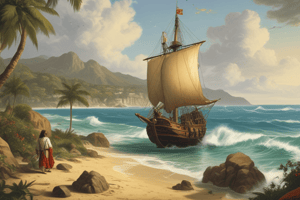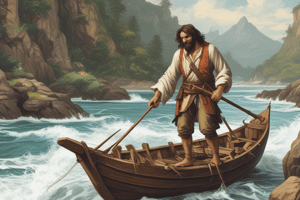Podcast
Questions and Answers
Robinson Crusoe gets shipwrecked off the coast of ______
Robinson Crusoe gets shipwrecked off the coast of ______
Virginia
Crusoe struggles to survive due to limited ______
Crusoe struggles to survive due to limited ______
resources
The new arrivals on the island bring their own set of ______
The new arrivals on the island bring their own set of ______
challenges
When Defoe wrote 'Crusoe', Britain had just completed the ______ Reformation
When Defoe wrote 'Crusoe', Britain had just completed the ______ Reformation
Crusoe returns home having learned valuable lessons about survival and ______
Crusoe returns home having learned valuable lessons about survival and ______
One of the castaways is killed while trying to escape from Crusoe's ______
One of the castaways is killed while trying to escape from Crusoe's ______
______ meant there were fewer restrictions imposed by religious authorities when writing novels
______ meant there were fewer restrictions imposed by religious authorities when writing novels
By depicting these ideas through a captivating adventure novel such as Crusoe, readers were able to empathize with the main protagonist's journey towards ______ amidst harsh conditions
By depicting these ideas through a captivating adventure novel such as Crusoe, readers were able to empathize with the main protagonist's journey towards ______ amidst harsh conditions
In terms of character development, Robinson Crusoe starts out very ______ and easily influenced
In terms of character development, Robinson Crusoe starts out very ______ and easily influenced
One major theme explored in 'Crusoe' is ______ as Robinson spends most of his time living solitarily on the island
One major theme explored in 'Crusoe' is ______ as Robinson spends most of his time living solitarily on the island
Although Crusoe doesn't actively mention God often, his strong ______ beliefs help guide him along tough times
Although Crusoe doesn't actively mention God often, his strong ______ beliefs help guide him along tough times
The use of symbolic items like tools signifies advancement in society; for example, once Crusoe acquires useful instruments like axes or firearms, his standard of living improves ______
The use of symbolic items like tools signifies advancement in society; for example, once Crusoe acquires useful instruments like axes or firearms, his standard of living improves ______
Flashcards are hidden until you start studying
Study Notes
Robinson Crusoe is a fictional work of literature written by Daniel Defoe and published in 1719. It's a narrative detailing the story of a young man named Robinson Crusoe who gets shipwrecked off the coast of Virginia, leaving him stranded on a desert island with only his faith and wits to keep him alive. Here, we will explore several key aspects of this classic tale, including its plot, the historical climate it was created within, the characters involved, the themes present, and the important symbols used throughout the book.
Plot Summary
The novel follows the adventures of Robinson Crusoe after he becomes marooned alone on a remote island following a failed business venture. He initially struggles to survive due to limited resources before eventually building himself a small settlement where he lives comfortably until other castaways reach the island two years later. These new arrivals bring their own set of challenges, giving rise to conflict which ultimately leads to one of them being killed while trying to escape from Crusoe's control. Eventually, Crusoe returns home having learned valuable lessons about survival and self-reliance, becoming more resourceful thanks to his experiences on the island.
Historical Context
When Defoe wrote 'Crusoe', Britain had just completed the Protestant Reformation some decades earlier. This meant there were fewer restrictions imposed by religious authorities when writing novels; however, they still needed to follow societal norms regarding what could be depicted in fiction. Additionally, during that time, exploration and colonization of new lands were common practice among European countries. By depicting these ideas through a captivating adventure novel such as Crusoe, readers were able to empathize with the main protagonist's journey towards independence amidst harsh conditions - something people might have experienced themselves in reality.
Character Analysis
In terms of character development, Robinson Crusoe starts out very naïve and easily influenced. As the story progresses though, he learns how to fend for himself using his wit and ingenuity rather than relying solely on others. Through hardship, he grows into someone capable of standing up against any adversary or challenge. His transformation is central to the overall message of the book, highlighting the importance of personal growth and resilience even under extreme circumstances.
Themes & Symbolism
Throughout 'Crusoe', various themes become apparent. One major theme explored is isolation as Robinson spends most of his time living solitarily on the island after being abandoned there. Another recurring motif revolves around religion; although Crusoe doesn't actively mention God often, his strong Christian beliefs help guide him along tough times while also providing ample motivation to persevere. Finally, the use of symbolic items like tools signifies advancement in society; for example, once Crusoe acquires useful instruments like axes or firearms, his standard of living improves dramatically. Overall, these elements combine to create an engaging narrative supported by meaningful symbolism.
In conclusion, 'Robinson Crusoe' explores many facets of human existence through its main character, Robinson Crusoe, whose journey mirrors real world events at the time of publication. In addition to being a fascinating piece of literature, 'Crusoe' holds relevance today because it continues to teach us valuable life lessons about surviving tough situations and growing into stronger individuals despite seemingly insurmountable odds.
Studying That Suits You
Use AI to generate personalized quizzes and flashcards to suit your learning preferences.



